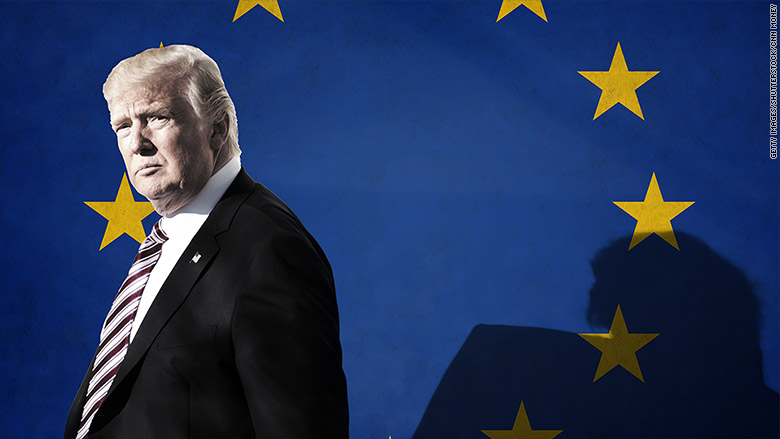Trump Vs. Europe: Unpacking The Roots Of The Trade Conflict

Table of Contents
Historical Context: A Shifting Transatlantic Relationship
Post-War Economic Order and its Challenges
The post-World War II economic order, built on multilateral institutions like the World Trade Organization (WTO) and the General Agreement on Tariffs and Trade (GATT), fostered unprecedented global economic growth. However, this system faced increasing challenges as global power dynamics shifted.
- Rise of the EU: The European Union's emergence as a powerful economic bloc challenged the long-standing US economic dominance.
- US Economic Dominance: While the US maintained significant economic influence, its relative share of global GDP declined, leading to anxieties about its economic standing.
- Emergence of New Global Players (China): The rapid rise of China as a major economic power further complicated the existing global economic order, adding another layer of complexity to US-EU relations.
- Growing Protectionist Sentiments Globally: A global increase in protectionist sentiments, manifested in increased tariffs and trade barriers, created a more challenging environment for free trade.
Early Signs of Friction: Pre-Trump Trade Disputes
Even before the Trump administration, simmering trade tensions existed between the US and the EU. These pre-existing disputes laid the groundwork for the later escalation of the trade conflict.
- Airbus-Boeing Dispute: This long-running dispute involved accusations of illegal government subsidies to both aircraft manufacturers, resulting in retaliatory tariffs on both sides. This exemplified the difficulties of enforcing fair trade practices in a complex global market.
- Agricultural Subsidies: Disagreements over agricultural subsidies, particularly those provided by the EU, consistently generated friction, highlighting the challenges of reconciling differing agricultural policies within a global trade framework. These pre-existing tensions became a focal point of contention during the Trump era.
The Trump Administration's "America First" Approach and its Impact on Europe
Tariffs and Trade Wars: A Breakdown of Key Disputes
The Trump administration's "America First" policy resulted in the imposition of significant tariffs on European goods, sparking a trade war.
- Steel and Aluminum Tariffs: The imposition of tariffs on steel and aluminum imports from the EU, justified on national security grounds, triggered immediate retaliatory measures from Europe.
- Agricultural Products: Tariffs were also levied on various agricultural products, further escalating the trade conflict and impacting farmers on both sides of the Atlantic. These actions led to significant economic repercussions.
- Economic Impact: Studies from organizations like the Peterson Institute for International Economics estimated the substantial economic costs of these tariffs, affecting industries and consumers in both the US and Europe. The impact of trade wars extended beyond direct tariff impacts.
Beyond Tariffs: Non-Tariff Barriers and Regulatory Differences
Beyond tariffs, non-tariff barriers and regulatory differences significantly contributed to the trade conflict.
- Data Privacy Regulations: Differing data privacy regulations, such as GDPR in Europe, created hurdles for transatlantic data flows and digital trade.
- Food Safety Standards: Disagreements over food safety standards and labeling requirements also posed challenges for trade in agricultural and food products. These issues created significant obstacles even beyond the direct impact of tariffs.
- Regulatory Hurdles: The cumulative effect of these non-tariff barriers hindered trade and investment flows, significantly impacting the overall economic relationship between the US and Europe.
Underlying Economic and Political Factors
The Rise of Protectionism and Nationalism
The US-EU trade conflict occurred within a broader global context of rising protectionist sentiments and nationalism.
- Global Trend: The rise of populist and nationalist movements across the globe contributed to a shift away from free trade and towards more protectionist policies.
- Political Backdrop: This global trend provided a political environment where protectionist policies were more palatable and less likely to face significant political opposition. The trade war was not an isolated incident but a symptom of larger geopolitical shifts.
Concerns over Trade Imbalances and Fair Trade Practices
The Trump administration expressed concerns about trade imbalances with Europe and accusations of unfair trade practices.
- Trade Deficits: The US consistently ran a trade deficit with Europe, fueling arguments about the need for a more balanced trade relationship.
- Accusations of Unfair Trade Practices: The US accused the EU of employing unfair trade practices, including subsidies and other trade barriers that gave European companies an unfair advantage.
- Counterarguments: The EU countered these arguments, highlighting its commitment to free and fair trade while pointing out instances of US protectionist practices. The arguments on both sides highlight the complexities of defining and enforcing “fair trade.”
Conclusion
The Trump vs. Europe trade conflict stemmed from a complex interplay of historical context, economic pressures, and political ideologies. Pre-existing trade disputes, coupled with the Trump administration's "America First" approach, led to a significant escalation of tensions, manifested through tariffs, non-tariff barriers, and broader disagreements about trade imbalances and fair trade practices. The global rise of protectionism and nationalism further fueled this conflict. Understanding these intricacies is crucial for navigating the future of US-EU trade relations. Continue learning about the complexities of Trump vs. Europe trade conflicts and their ongoing impact on the global economy.

Featured Posts
-
 Carolina Country Music Fest 2025 Sells Out A Record Breaking Year
May 25, 2025
Carolina Country Music Fest 2025 Sells Out A Record Breaking Year
May 25, 2025 -
 Escape To The Country Practical Steps For A Smooth Transition
May 25, 2025
Escape To The Country Practical Steps For A Smooth Transition
May 25, 2025 -
 La Charentaise A Saint Brieuc Une Tradition Chausseur Qui Perdure
May 25, 2025
La Charentaise A Saint Brieuc Une Tradition Chausseur Qui Perdure
May 25, 2025 -
 Amundi Msci World Ii Ucits Etf Dist Net Asset Value Nav Explained
May 25, 2025
Amundi Msci World Ii Ucits Etf Dist Net Asset Value Nav Explained
May 25, 2025 -
 Nashemu Pokoleniyu Chto To Udalos Vzglyad Na Sovremennost Skvoz Prizmu Istorii
May 25, 2025
Nashemu Pokoleniyu Chto To Udalos Vzglyad Na Sovremennost Skvoz Prizmu Istorii
May 25, 2025
